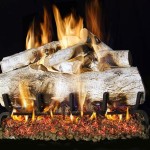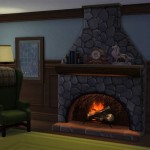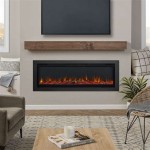Fireplace Tile Surrounds: Enhancing Functionality and Aesthetics
Fireplace tile surrounds represent a significant element in home design, combining functionality with aesthetic appeal. They protect the surrounding wall from heat damage and soot, while simultaneously serving as a focal point within a room. The selection of appropriate tile materials, designs, and installation techniques are vital for achieving both the desired visual effect and long-term durability.
The primary purpose of a fireplace surround is to provide fire resistance. The immediate area around a fireplace is subjected to high temperatures, which can potentially damage drywall, paint, or wallpaper. Tile, being a non-combustible material, creates a protective barrier, minimizing the risk of fire hazards and structural damage. Moreover, tile surfaces are easier to clean than other materials, simplifying the removal of soot and ash that inevitably accumulate around a fireplace.
Selecting the Right Tile Material
The choice of tile material is a critical factor influencing both the performance and the appearance of the fireplace surround. Several options are available, each possessing distinct characteristics that make them suitable for different applications. Common choices include ceramic, porcelain, natural stone (such as marble, granite, and slate), and decorative options like glass or metal tiles.
Ceramic tile is a popular option due to its affordability, versatility, and wide range of available colors and patterns. It is relatively easy to install and maintain, making it a practical choice for many homeowners. However, ceramic tile is less dense than porcelain and may be more susceptible to cracking or chipping under extreme heat fluctuations. Porcelain tile, on the other hand, is denser and more durable, rendering it a better choice for fireplaces that are used frequently or experience higher temperatures. Porcelain is also water-resistant, which can be beneficial in areas prone to moisture.
Natural stone tiles, such as marble, granite, and slate, offer a luxurious and timeless aesthetic. Marble provides a classic elegance with its unique veining patterns, while granite boasts exceptional durability and heat resistance. Slate offers a rustic and textured appearance, adding warmth and character to the fireplace surround. However, natural stone tiles typically require sealing to protect them from staining and moisture absorption and may be more expensive than ceramic or porcelain options.
Glass and metal tiles add a contemporary flair to fireplaces. Glass tiles can reflect light, creating a visually appealing focal point, while metal tiles contribute a sleek and modern aesthetic. These materials often come in various sizes, shapes, and finishes, allowing for creative design possibilities. However, glass and metal tiles may not be as heat-resistant as other options, so careful consideration should be given to their placement and the intensity of the fireplace use.
Design Considerations and Installation Techniques
The design of the fireplace tile surround should complement the overall style of the room. Factors such as color, pattern, texture, and layout contribute to the visual impact of the fireplace. The surrounding architecture and existing décor should be considered when choosing a tile design. For instance, a contemporary room might benefit from a minimalist design with large-format tiles, while a traditional room may be enhanced by intricate patterns and decorative accents.
The size and shape of the tiles also play a significant role in the overall aesthetic. Smaller tiles can create intricate mosaics or detailed patterns, while larger tiles offer a more streamlined and modern look. Rectangular tiles can be arranged in various patterns, such as brick bond, herringbone, or stacked layouts, adding visual interest to the fireplace surround.
Proper installation is crucial for ensuring the longevity and performance of the tile surround. The surface to which the tiles are applied must be clean, level, and structurally sound. The appropriate type of mortar or adhesive should be selected based on the tile material and the substrate. A thin-set mortar is commonly used for installing tiles, ensuring proper adhesion and a smooth surface. Grouting is then applied to fill the gaps between the tiles, providing a watertight seal and enhancing the visual appeal. The grout color should complement the tile and the overall design scheme.
Expansion joints should be incorporated into the tile surround to accommodate thermal expansion and contraction. These joints prevent cracking or buckling of the tiles due to temperature fluctuations. The placement and size of expansion joints should be determined based on the size of the tile surround and the expected temperature variations. A professional tile installer can provide guidance on the proper placement and installation of expansion joints.
Maintaining and Cleaning Tile Fireplace Surrounds
Maintaining a tile fireplace surround is essential for preserving its appearance and extending its lifespan. Regular cleaning helps remove soot, ash, and other debris that can accumulate on the tile surface. The cleaning process should involve using mild detergents and soft cloths to avoid scratching or damaging the tile. Abrasive cleaners and harsh chemicals should be avoided, especially on natural stone tiles.
Grout lines are particularly susceptible to staining and discoloration. Regular cleaning with a grout brush and a specialized grout cleaner can help maintain their appearance. Sealing the grout lines can also prevent staining and moisture absorption. The frequency of grout sealing depends on the type of grout and the level of usage.
For natural stone tiles, periodic sealing is necessary to protect them from staining and moisture damage. The type of sealant should be specifically designed for the type of stone being used. Consult with a stone care professional for recommendations on the appropriate sealant and application process. Regular inspection of the tile surround for cracks, chips, or loose tiles is also important. Addressing any issues promptly can prevent further damage and maintain the structural integrity of the surround.
The selection, installation, and maintenance of fireplace tile surrounds are critical considerations for homeowners seeking to enhance the functionality and aesthetic appeal of their fireplaces. By carefully considering the appropriate materials, designs, and installation techniques, a tile fireplace surround can provide years of reliable performance and visual enjoyment.

Hot Fireplace Tile Trends Bedrosians Stone

Fireplace Tile Ideas Designs To Inspire You

Fireplace Tiles Classique Floors Tile Portland Or

53 Best Fireplace Tile Ideas And Designs With S For 2024 Mantel Decor Marble Surround Surrounds
These Tiled Fireplaces Are Swoon Worthy Tileist By Tilebar

14 Fresh Designs For Tiled Fireplaces Bob Vila

Remodeling A Fireplace With Tile

Fireplace Tile Ideas Designs To Inspire You

Fireplace Feature Wall Ideas Queen City Stone Tile
Fireplace Tile Surround 5 Decorative Mantel Tiles 2024
Related Posts








